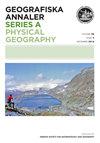Establishing a record of extreme debris flow events in a high Alpine catchment since the end of the Little Ice Age using lichenometric dating
IF 1.8
4区 地球科学
Q3 GEOGRAPHY, PHYSICAL
Geografiska Annaler Series A-Physical Geography
Pub Date : 2023-01-02
DOI:10.1080/04353676.2023.2187531
引用次数: 1
Abstract
ABSTRACT Establishing a record of large debris flow events in high Alpine areas prior to the availability of high resolution remote sensing data can be very challenging. In this study, we investigate the debris flow activity in two tributary valleys of the Horlachtal catchment in Tyrol, Austria between the end of the Little Ice Age at about 1850 and the first available area wide aerial images from 1947. To accomplish this, we calculated a local lichenometric calibration curve using the long axis diameters of the five largest Rhizocarpon lichen thalli at 51 different reference locations. Because of the interval-censored dating of most of the reference sites, we established a bootstrapping approach within the calibration curve calculation process. With the help of the lichenometric calibration data, we were able to date 47 old debris flow deposits in the study area. The results indicate no increasing or decreasing trends in frequencies of extreme debris flow events. In addition, the results point to a very local character of debris flow triggering precipitation events, as we can detect major differences in neighbouring valleys. Lichenometric derived datings also provide temporal informations about the end of debris flow activity at some sites in the study area and thus can contribute to a better understanding of debris flow systems.利用地衣测定年代法建立了小冰期结束以来高寒流域极端泥石流事件的记录
在获得高分辨率遥感数据之前,在高寒地区建立大型泥石流事件的记录是非常具有挑战性的。在这项研究中,我们调查了奥地利蒂罗尔Horlachtal流域的两个支流山谷的泥石流活动,从1850年小冰期结束到1947年第一个可用的区域航拍图像。为了实现这一目标,我们在51个不同的参考位置,利用5个最大的根卡霉地衣菌体的长轴直径计算了局部地衣计量校准曲线。由于大多数参考点的测年存在间隔截除,我们在标定曲线计算过程中建立了一种自举方法。在地衣测量校准数据的帮助下,我们能够确定研究区域47个古老的泥石流沉积物的年代。结果表明,极端泥石流事件的发生频率没有增加或减少的趋势。此外,结果表明泥石流触发降水事件具有非常局部的特征,因为我们可以在邻近的山谷中发现重大差异。地衣测定法得出的年代测定法还提供了研究区内某些地点泥石流活动结束的时间信息,从而有助于更好地了解泥石流系统。
本文章由计算机程序翻译,如有差异,请以英文原文为准。
求助全文
约1分钟内获得全文
求助全文
来源期刊
CiteScore
3.60
自引率
0.00%
发文量
12
审稿时长
>12 weeks
期刊介绍:
Geografiska Annaler: Series A, Physical Geography publishes original research in the field of Physical Geography with special emphasis on cold regions/high latitude, high altitude processes, landforms and environmental change, past, present and future.
The journal primarily promotes dissemination of regular research by publishing research-based articles. The journal also publishes thematic issues where collections of articles around a specific themes are gathered. Such themes are determined by the Editors upon request. Finally the journal wishes to promote knowledge and understanding of topics in Physical Geography, their origin, development and current standing through invited review articles.

 求助内容:
求助内容: 应助结果提醒方式:
应助结果提醒方式:


